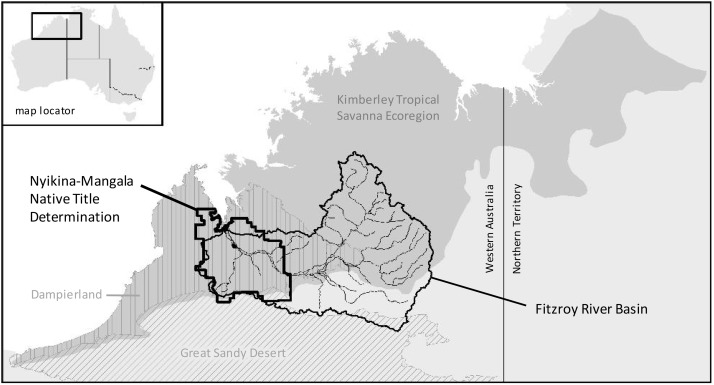当前位置:
X-MOL 学术
›
Environ. Impact Assess. Rev.
›
论文详情
Our official English website, www.x-mol.net, welcomes your
feedback! (Note: you will need to create a separate account there.)
Moving from reactive to proactive development planning to conserve Indigenous community and biodiversity values
Environmental Impact Assessment Review ( IF 9.8 ) Pub Date : 2019-01-01 , DOI: 10.1016/j.eiar.2018.09.002 Michael Heiner , David Hinchley , James Fitzsimons , Frank Weisenberger , Wayne Bergmann , Tina McMahon , Joseph Milgin , Linda Nardea , James Oakleaf , Damien Parriman , Anne Poelina , Harry Watson , Kimberley Watson , Joseph Kiesecker
Environmental Impact Assessment Review ( IF 9.8 ) Pub Date : 2019-01-01 , DOI: 10.1016/j.eiar.2018.09.002 Michael Heiner , David Hinchley , James Fitzsimons , Frank Weisenberger , Wayne Bergmann , Tina McMahon , Joseph Milgin , Linda Nardea , James Oakleaf , Damien Parriman , Anne Poelina , Harry Watson , Kimberley Watson , Joseph Kiesecker

|
Abstract There is increased awareness of the need to balance multiple societal values in land use and development planning. Best practice has promoted the use of landscape-level conservation planning and application of the ‘mitigation hierarchy’, which focuses on avoiding, minimizing or compensating for impacts of development projects. However, environmental impact assessments (EIA) typically focus in a reactive way on single project footprints with an emphasis on environmental values and specifically biodiversity. This separation may miss opportunities to jointly plan for and manage impacts to both environmental and social values. Integrated approaches may have particular benefit in northern Australia, where Indigenous people have native title to as much as 60% of the land area and cultural values are closely linked with natural values. Here, we present a novel framework for integrating biodiversity and cultural values to facilitate use in EIA processes, using the Nyikina Mangala Native Title Determination Area in the Kimberley, Western Australia, as a case study. We demonstrate 1) how social and cultural values can be organized and analyzed spatially to support mitigation planning, 2) how social, cultural, and biodiversity values may reinforce each other to deliver better conservation outcomes and minimize conflict, and 3) how this information, in the hands of Indigenous communities, provides capacity to proactively assess development proposals and negotiate mitigation measures to conserve social, cultural, and biodiversity values following the mitigation hierarchy. Based on values defined through a Healthy Country Planning process, we developed spatial datasets to represent cultural/heritage sites, freshwater features, common native animals and plants represented by biophysical habitat types, and legally-protected threatened and migratory species represented by potential habitat models. Both cultural/heritage sites and threatened species habitat show a strong thematic and spatial link with freshwater features, particularly the Fitzroy River wetlands. We outline some of the challenges and opportunities of this process and its implications for the Northern Australia development agenda.
中文翻译:

从被动发展规划转变为主动发展规划,以保护土著社区和生物多样性价值
摘要 人们越来越意识到需要在土地使用和开发规划中平衡多种社会价值。最佳实践促进了景观级保护规划的使用和“缓解等级”的应用,其重点是避免、最小化或补偿开发项目的影响。然而,环境影响评估 (EIA) 通常以被动方式关注单个项目足迹,并强调环境价值,特别是生物多样性。这种分离可能会错过共同规划和管理对环境和社会价值的影响的机会。综合方法可能在澳大利亚北部特别受益,那里的土著人拥有多达 60% 的土地面积,文化价值与自然价值密切相关。这里,我们以西澳大利亚州金伯利的 Nyikina Mangala 土著产权确定区为例,提出了一个整合生物多样性和文化价值的新框架,以促进在 EIA 过程中的使用。我们展示了 1) 如何在空间上组织和分析社会和文化价值以支持缓解规划,2) 社会、文化和生物多样性价值如何相互加强以提供更好的保护成果并最大限度地减少冲突,以及 3) 这些信息如何,在土著社区手中,提供主动评估发展建议和协商缓解措施的能力,以按照缓解等级保护社会、文化和生物多样性价值。基于通过健康国家规划过程定义的价值观,我们开发了空间数据集来表示文化/遗产地、淡水特征、以生物物理栖息地类型为代表的常见本地动植物,以及以潜在栖息地模型为代表的受法律保护的受威胁和迁徙物种。文化/遗产地和受威胁物种栖息地都显示出与淡水特征,尤其是菲茨罗伊河湿地的强烈主题和空间联系。我们概述了这一进程的一些挑战和机遇及其对澳大利亚北部发展议程的影响。文化/遗产地和受威胁物种栖息地都显示出与淡水特征,尤其是菲茨罗伊河湿地的强烈主题和空间联系。我们概述了这一进程的一些挑战和机遇及其对澳大利亚北部发展议程的影响。文化/遗产地和受威胁物种栖息地都显示出与淡水特征,尤其是菲茨罗伊河湿地的强烈主题和空间联系。我们概述了这一进程的一些挑战和机遇及其对澳大利亚北部发展议程的影响。
更新日期:2019-01-01
中文翻译:

从被动发展规划转变为主动发展规划,以保护土著社区和生物多样性价值
摘要 人们越来越意识到需要在土地使用和开发规划中平衡多种社会价值。最佳实践促进了景观级保护规划的使用和“缓解等级”的应用,其重点是避免、最小化或补偿开发项目的影响。然而,环境影响评估 (EIA) 通常以被动方式关注单个项目足迹,并强调环境价值,特别是生物多样性。这种分离可能会错过共同规划和管理对环境和社会价值的影响的机会。综合方法可能在澳大利亚北部特别受益,那里的土著人拥有多达 60% 的土地面积,文化价值与自然价值密切相关。这里,我们以西澳大利亚州金伯利的 Nyikina Mangala 土著产权确定区为例,提出了一个整合生物多样性和文化价值的新框架,以促进在 EIA 过程中的使用。我们展示了 1) 如何在空间上组织和分析社会和文化价值以支持缓解规划,2) 社会、文化和生物多样性价值如何相互加强以提供更好的保护成果并最大限度地减少冲突,以及 3) 这些信息如何,在土著社区手中,提供主动评估发展建议和协商缓解措施的能力,以按照缓解等级保护社会、文化和生物多样性价值。基于通过健康国家规划过程定义的价值观,我们开发了空间数据集来表示文化/遗产地、淡水特征、以生物物理栖息地类型为代表的常见本地动植物,以及以潜在栖息地模型为代表的受法律保护的受威胁和迁徙物种。文化/遗产地和受威胁物种栖息地都显示出与淡水特征,尤其是菲茨罗伊河湿地的强烈主题和空间联系。我们概述了这一进程的一些挑战和机遇及其对澳大利亚北部发展议程的影响。文化/遗产地和受威胁物种栖息地都显示出与淡水特征,尤其是菲茨罗伊河湿地的强烈主题和空间联系。我们概述了这一进程的一些挑战和机遇及其对澳大利亚北部发展议程的影响。文化/遗产地和受威胁物种栖息地都显示出与淡水特征,尤其是菲茨罗伊河湿地的强烈主题和空间联系。我们概述了这一进程的一些挑战和机遇及其对澳大利亚北部发展议程的影响。











































 京公网安备 11010802027423号
京公网安备 11010802027423号